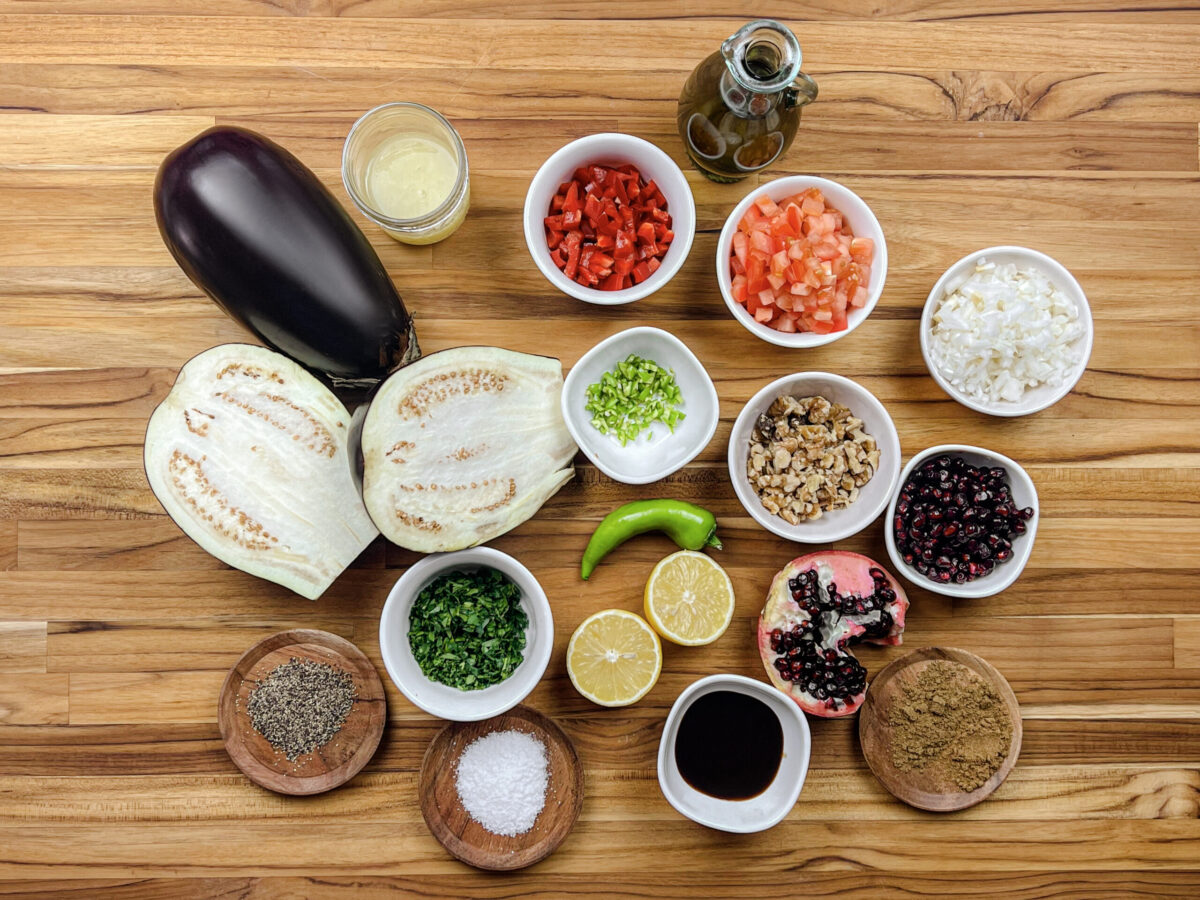Growing up, the aroma of charred eggplants wafting through our home signaled one thing: Baba Ghanoush season! This beloved dish holds a special place in my heart and table. Dive into my personal spin on this Mediterranean classic and let its smoky, tangy flavors whisk you away!
Table of Contents
Eggplant season has arrived, and in the heart of Mediterranean cuisine, that signifies it’s time for two star dishes in my kitchen: Baba Ghanoush and Moutabal. These two iconic eggplant dip recipes, rich in roasted flavor, share similar preparation methods.
For that authentic Baba Ghanoush taste, grilling the eggplants on a BBQ is your best bet. The smoky, charred flavor it imparts is hard to mimic. Direct roasting on a gas stove is another technique, but be prepared for a mess! If convenience is what you’re after, roasting them in the oven remains the easiest, giving you a foundation for many recipes with roasted eggplant.
Delving into the dish, Baba Ghanoush isn’t just another eggplant dip; it’s a vibrant salad teeming with rich Mediterranean flavors. My version brims with fresh tomatoes, onions, sweet red peppers, and a burst of pomegranate seeds. Adding some walnuts, a squeeze of lemon, and a hint of garlic gives it that perfect balance.
The magic of Baba Ghanoush’s Recipe hit me many years ago during a family trip to Syria. Tasting the Syrian variant of this eggplant dip recipe was like a culinary explosion. The dance of sweet and sour notes was an unforgettable palate experience, a taste of the authentic Baba Ghanoush recipe that lingers even today.
Ingredients for your Baba Ghanoush Recipe
- Large Eggplants: Creamy texture and smoky flavor after roasting.
- Tablespoons Olive Oil (divided): Richness and moisture in the dish, especially during roasting.
- Small Onion (diced), Small Red Pepper (diced), Small Jalapeno (diced): Layers of sweetness, subtle heat, and a touch of spiciness.
- Salt, Black Pepper, Cumin, Coriander: Balancing the flavors, adding warmth and depth to the dish.
- Pomegranate Molasses: Sweet and tangy notes contribute complexity to the overall taste.
- Cloves Garlic (minced): Pungent aroma and savory depth.
- Fresh Lemon Juice: Bright, citrusy freshness.
- Small Tomato (diced): Juicy sweetness, enhancing the overall freshness.
- Italian Parsley (chopped): Fresh herbal notes, adding a bright finish.
- Walnuts (chopped, divided): Nutty richness and crunch.
- Pomegranate Seeds (divided): Bursting sweetness and vibrant texture.
Roasted Eggplant for the Ultimate Baba Ghanoush
Preparation Steps
- Initial Preparations: Start by slicing the eggplants lengthwise. Lay them skin-side up, brush them generously with olive oil, and then turn them over, flat side facing down, on a baking tray.
- Roasting: Place them in an oven preheated to 400 F. They should be tender and ready in approximately 25 minutes. As a tip, you can use the same fork test mentioned earlier to ensure readiness.
- Cooling & Draining: Once done, allow them to cool to a comfortable handling temperature. Using a bowl and strainer, scoop the pulpy, meaty part of the eggplant into the strainer. Let it sit, draining excess moisture for about 20 minutes. A gentle press with the back of a spoon can expedite this.
- Flavor Infusion: I enhance my Baba Ghanoush by sautéing onions, garlic, red pepper, and jalapeno in olive oil with spices and pomegranate molasses. Cooked until slightly soft, they’re cooled and blended with the roasted eggplant for a flavorful kick.
How to Serve Baba Ghanoush: More Than Just a Dip
- A-Pillar of Mezza: Baba Ghanoush stands tall among the iconic mezza dishes of the Mediterranean and Middle Eastern cuisines. This assortment often includes hummus, mouhammara, moutabal, tabbouleh, and kibbeh. When part of a mezze spread, it offers a smoky contrast to the other flavors on the plate.
- Dip with Pita: The classic way many prefer Baba Ghanoush is a dip paired with warm pita bread. This combination brings out the dish’s rich texture and intricate flavors.
- Spread for Sandwiches: Looking for a way to elevate your sandwich? Spread a generous layer of Baba Ghanoush on your bread or wrap. It pairs beautifully with grilled vegetable meats or simply on its own for a vegan treat.
- Pasta Sauce Alternative: For experimenters, toss your pasta in a Baba Ghanoush sauce. The smoky, tangy flavor can be a delightful twist to traditional pasta dishes.
Preparation



Preheat the oven to 425F. Cut the eggplants lengthwise and brush each half with 2 tablespoons of olive oil. Place them on a baking sheet, flat side down. Roast in the oven for about 35 minutes or until they're tender and aromatic. Once done, set them aside to cool off.

While the eggplants are in the oven, heat a pan over medium-high heat. Add 1 tablespoon of olive oil. Toss in the diced onion, red pepper, and jalapeno. Sauté this aromatic blend for 3 minutes. Season with ½ teaspoon of salt, 1 teaspoon each of black pepper and cumin, and ½ teaspoon of coriander. Blend these together and sauté for an additional 2 minutes. Finally, enhance this medley by drizzling with 1 tablespoon of molasses. Remove from heat and set aside.

Once your eggplant has cooled to a touch-friendly temperature, scoop out the luscious flesh, leaving the skin behind. Place this flesh in a strainer set over a bowl. Let gravity do its job, but you can give it a gentle nudge by pressing the eggplant with the back of a spoon to release more moisture.

Transfer it to a clean bowl. Stir in the fresh lemon juice and the aromatic minced garlic. Now, fold in the sautéed onion mixture, followed by the diced tomatoes. Sprinkle in the Italian parsley, half of the walnuts, and half of the pomegranate seeds. Mix all these together, immersing them in a symphony of flavors. Add the remaining salt, give it a good mix, and adjust seasoning if needed.

Dish out your baba ganoush. Make a small well in the center. Garnish with the remaining pomegranate seeds and walnuts. For that finishing touch, drizzle over the remaining molasses and a good amount of olive oil. Whether you serve it cold or at room temperature, this dish pairs best with warm pita bread. Dive in and enjoy every bite!
Ingredients:
Adjust Servings
| 2 large eggplant | |
| 2 large eggplants 4 tablespoons olive oil, divided (plus more for drizzling | |
| 1 small onion, diced | |
| 1 small red pepper, diced | |
| 1 small jalapeno, diced | |
| 1 ½ teaspoons salt, divided | |
| 1 teaspoon black pepper | |
| 1 teaspoon cumin | |
| ½ teaspoon coriander | |
| 2 tablespoons molasses, divided | |
| 4 cloves garlic, minced | |
| ⅓ cup fresh lemon juice | |
| 1 small tomato, diced | |
| ¼ cup Italian parsley, chopped | |
| ½ cup walnuts, chopped, divided | |
| ½ cup pomegranate seeds, divided |







I would love to hear your experience!
Did you try out this recipe? I’d love to hear your thoughts! Please leave a comment below and share your Baba Ghanoush experience with our community.